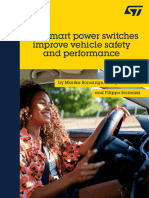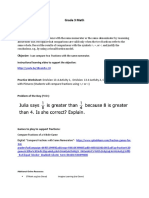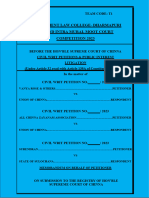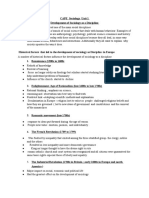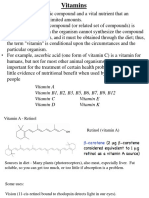A Gentle Reminder
A Gentle Reminder
Uploaded by
adham aliCopyright:
Available Formats
A Gentle Reminder
A Gentle Reminder
Uploaded by
adham aliCopyright
Available Formats
Share this document
Did you find this document useful?
Is this content inappropriate?
Copyright:
Available Formats
A Gentle Reminder
A Gentle Reminder
Uploaded by
adham aliCopyright:
Available Formats
See discussions, stats, and author profiles for this publication at: https://www.researchgate.
net/publication/41850032
A gentle reminder
Article in Pediatric Radiology · March 2010
DOI: 10.1007/s00247-010-1601-2 · Source: PubMed
CITATIONS READS
0 7,115
1 author:
David A Bloom
Beaumont Health System
37 PUBLICATIONS 610 CITATIONS
SEE PROFILE
All content following this page was uploaded by David A Bloom on 20 August 2014.
The user has requested enhancement of the downloaded file.
Pediatr Radiol (2010) 40:1323
DOI 10.1007/s00247-010-1601-2
EDITORIAL
A gentle reminder
David A. Bloom
Received: 25 January 2010 / Accepted: 9 February 2010 / Published online: 10 March 2010
# Springer-Verlag 2010
As we have all come to appreciate, there are many reasons where in retrospect the limited postoperative esophagram at
for reading a journal article. For many, it is a way of learning day 7 of life suggested a distal esophageal stricture (usually too
about a topic, and yet for others, it is a way of confirming what young to have already developed a reflux stricture). Then
is already known by the reader. I, on occasion, use journal 4 years after that, there was a child with a congenital
articles to see what my contemporaries, colleagues, and esophageal stenosis suggested by postoperative esophagram
friends are writing about—what puts the “wind in their sails.” who we are currently following as there are no clinical
Earning continuing education credits, formulating research symptoms (mild distal esophageal narrowing by routine
ideas, and learning from different writing styles are all screening esophagram looking for post-anastamotic stricture).
benefits that come from reading an original article, review, Now we are presented with the “gentle reminder”—that
pictorial essay, or case report. Yet the one for me that trumps congenital esophageal stenosis is associated with EA/TEF
them all is the “gentle reminder,” namely the article that (12% of patients in the current article), and that CES is
reminds me of an important concept I once knew, still tucked frequently symptomatic (45% of the CES cases in this series)
in the back of my memory, but one I do not see often enough and often fails balloon dilatation, the standard of care for
to have at the ready. In other words, it’s the one I might miss reflux strictures. Mostly, for me, this article reminds me that
without the “gentle reminder.” one has an invaluable opportunity to study the distal
The article titled “Congenital esophageal stenosis asso- esophagus in patients with EA/TEF at the first postoperative
ciated with esophageal atresia/tracheoesophageal fistula: esophagram. We are so focused on looking for anastamotic
clinical and radiologic features,” by Yoo and colleagues [1], leaks and recurrent/residual tracheoesophageal fistulae that
falls easily into this last category. I am sure that some of we may lose sight of the fact that there can be anomalies of the
you have had a case of congenital esophageal stenosis remaining distal esophagus. Even in patients who are to
(CES) with esophageal atresia/tracheoesophageal fistula undergo delayed repair, with either temporizing proximal
(EA/TEF) in which you saw the finding, did a literature search esophageal pouch decompression by an enteric tube or
or showed a colleague, and followed up with the pediatric cervical esophagostomy, fistula takedown and gastrostomy
surgeon to see what the lesion turned out to be. I clearly tube insertion, evaluation of the distal esophagus can be per-
remember a case from my fellowship, with the subsequent formed safely and effectively. By performing a gastrostomy
noon conference discussion about complete cartilaginous tube study, one may be able to reflux the distal esophagus to
rings/tracheobronchial remnants as one cause of the distal look for CES. The opportunity is there, if we remember to take
stenosis. And I recall another case 10 years later, where CES it. Our patients will be the true beneficiaries. To Dr. Yoo and
was at first called a reflux stricture in a 2-year-old after colleagues, thank you for the “gentle reminder.”
neonatal repair of EA/TEF, with unsuccessful balloon dilata-
tion and subsequent esophageal perforation after bougienage,
Reference
D. A. Bloom (*)
Section of Pediatric Radiology, Beaumont Children’s Hospital,
Department of Radiology, William Beaumont Hospital, 1. Yoo HJ, Kim WS, Cheon J-E et al (2010) Congenital esophageal
3601 West 13 Mile Road, stenosis associated with esophageal atresia/tracheoesophageal fistula:
Royal Oak, MI 48073, USA clinical and radiologic features. Pediatr Radiol 40: doi: 10.1007/
e-mail: david.bloom@beaumont.edu s00247-010-1603-0
View publication stats
You might also like
- The Subtle Art of Not Giving a F*ck: A Counterintuitive Approach to Living a Good LifeFrom EverandThe Subtle Art of Not Giving a F*ck: A Counterintuitive Approach to Living a Good LifeRating: 4 out of 5 stars4/5 (6016)
- The Gifts of Imperfection: Let Go of Who You Think You're Supposed to Be and Embrace Who You AreFrom EverandThe Gifts of Imperfection: Let Go of Who You Think You're Supposed to Be and Embrace Who You AreRating: 4 out of 5 stars4/5 (1112)
- Never Split the Difference: Negotiating As If Your Life Depended On ItFrom EverandNever Split the Difference: Negotiating As If Your Life Depended On ItRating: 4.5 out of 5 stars4.5/5 (909)
- Grit: The Power of Passion and PerseveranceFrom EverandGrit: The Power of Passion and PerseveranceRating: 4 out of 5 stars4/5 (619)
- Hidden Figures: The American Dream and the Untold Story of the Black Women Mathematicians Who Helped Win the Space RaceFrom EverandHidden Figures: The American Dream and the Untold Story of the Black Women Mathematicians Who Helped Win the Space RaceRating: 4 out of 5 stars4/5 (937)
- Shoe Dog: A Memoir by the Creator of NikeFrom EverandShoe Dog: A Memoir by the Creator of NikeRating: 4.5 out of 5 stars4.5/5 (546)
- The Hard Thing About Hard Things: Building a Business When There Are No Easy AnswersFrom EverandThe Hard Thing About Hard Things: Building a Business When There Are No Easy AnswersRating: 4.5 out of 5 stars4.5/5 (358)
- TEMPLATE - Odoo Offer For PartnersDocument37 pagesTEMPLATE - Odoo Offer For Partnersjoel nugrohoNo ratings yet
- Her Body and Other Parties: StoriesFrom EverandHer Body and Other Parties: StoriesRating: 4 out of 5 stars4/5 (831)
- Elon Musk: Tesla, SpaceX, and the Quest for a Fantastic FutureFrom EverandElon Musk: Tesla, SpaceX, and the Quest for a Fantastic FutureRating: 4.5 out of 5 stars4.5/5 (479)
- The Emperor of All Maladies: A Biography of CancerFrom EverandThe Emperor of All Maladies: A Biography of CancerRating: 4.5 out of 5 stars4.5/5 (275)
- The Little Book of Hygge: Danish Secrets to Happy LivingFrom EverandThe Little Book of Hygge: Danish Secrets to Happy LivingRating: 3.5 out of 5 stars3.5/5 (434)
- The World Is Flat 3.0: A Brief History of the Twenty-first CenturyFrom EverandThe World Is Flat 3.0: A Brief History of the Twenty-first CenturyRating: 3.5 out of 5 stars3.5/5 (2281)
- The Yellow House: A Memoir (2019 National Book Award Winner)From EverandThe Yellow House: A Memoir (2019 National Book Award Winner)Rating: 4 out of 5 stars4/5 (99)
- The Sympathizer: A Novel (Pulitzer Prize for Fiction)From EverandThe Sympathizer: A Novel (Pulitzer Prize for Fiction)Rating: 4.5 out of 5 stars4.5/5 (125)
- Devil in the Grove: Thurgood Marshall, the Groveland Boys, and the Dawn of a New AmericaFrom EverandDevil in the Grove: Thurgood Marshall, the Groveland Boys, and the Dawn of a New AmericaRating: 4.5 out of 5 stars4.5/5 (273)
- A Heartbreaking Work Of Staggering Genius: A Memoir Based on a True StoryFrom EverandA Heartbreaking Work Of Staggering Genius: A Memoir Based on a True StoryRating: 3.5 out of 5 stars3.5/5 (232)
- Team of Rivals: The Political Genius of Abraham LincolnFrom EverandTeam of Rivals: The Political Genius of Abraham LincolnRating: 4.5 out of 5 stars4.5/5 (235)
- On Fire: The (Burning) Case for a Green New DealFrom EverandOn Fire: The (Burning) Case for a Green New DealRating: 4 out of 5 stars4/5 (75)
- The Unwinding: An Inner History of the New AmericaFrom EverandThe Unwinding: An Inner History of the New AmericaRating: 4 out of 5 stars4/5 (45)
- Brandin LeBlanc - Revised PDFDocument3 pagesBrandin LeBlanc - Revised PDFvrb1260% (3)
- Ionic Compounds NKCSDDocument28 pagesIonic Compounds NKCSDRalph Bryan HidalgoNo ratings yet
- En - WP How Smart Power Switches Improve Vehicle Safety and PerformaDocument13 pagesEn - WP How Smart Power Switches Improve Vehicle Safety and Performaanisnk2003No ratings yet
- An Context-Aware Management and Control Mechanism in A MobileDocument12 pagesAn Context-Aware Management and Control Mechanism in A MobilePrasath SivaSubramanianNo ratings yet
- NotificationDocument2 pagesNotificationlpgchinna2382No ratings yet
- Track Consignment 2Document2 pagesTrack Consignment 2Aarthi PriyaNo ratings yet
- Chemistry 1 - ExamDocument6 pagesChemistry 1 - Examnassorussi9No ratings yet
- It 3rd Year SllabusDocument50 pagesIt 3rd Year Sllabushifzan786No ratings yet
- MR GMAT MathEssentials 6EDocument166 pagesMR GMAT MathEssentials 6EKsifounon Ksifounou100% (1)
- Projetion of Straight Line ProblemDocument3 pagesProjetion of Straight Line ProblemRajesh JunghareNo ratings yet
- Grade 3 Math: 3.NF.3d Day 14Document18 pagesGrade 3 Math: 3.NF.3d Day 14Apichartj JusuayNo ratings yet
- T1 Petitioner780Document44 pagesT1 Petitioner780Arvint rajtvNo ratings yet
- CAPE Sociology Unit 1 .2Document2 pagesCAPE Sociology Unit 1 .2Drip BossNo ratings yet
- CTM Macau v6 - May 17Document4 pagesCTM Macau v6 - May 17gopiv2020No ratings yet
- Tutorial 3Document7 pagesTutorial 3Bishesh DangolNo ratings yet
- Caste, Culture and HegemonyDocument1 pageCaste, Culture and HegemonyPransankar MajumdarNo ratings yet
- Diffusion in Solids: Course: Mass Transfer (TH) Batch: 2019/fall Semester: 4thDocument50 pagesDiffusion in Solids: Course: Mass Transfer (TH) Batch: 2019/fall Semester: 4thKnock Knock Tera baapNo ratings yet
- DNA Methylation Age Analysis of Rapamycin in Common MarmosetsDocument13 pagesDNA Methylation Age Analysis of Rapamycin in Common Marmosetsender000No ratings yet
- RajatDocument83 pagesRajatrajatkattimani100% (1)
- Logistics Network Configuration: Kaminsky@ieor - Berkeley.eduDocument65 pagesLogistics Network Configuration: Kaminsky@ieor - Berkeley.edugadde bharatNo ratings yet
- Vitamin A Vitamin B1, B2, B3, B5, B6, B7, B9, B12 Vitamin C Vitamin E Vitamin D Vitamin KDocument28 pagesVitamin A Vitamin B1, B2, B3, B5, B6, B7, B9, B12 Vitamin C Vitamin E Vitamin D Vitamin KSajanMaharjan100% (1)
- 5-Placing Theory - PlowrightDocument12 pages5-Placing Theory - PlowrightIsnainiNurJannahNo ratings yet
- 13 Thjan 20200Document229 pages13 Thjan 20200Mokarrom Hossain100% (1)
- Luxury Thesis PDFDocument8 pagesLuxury Thesis PDFveronicarogerskansascity100% (1)
- Itr1 PreviewDocument9 pagesItr1 Previewdrali508482No ratings yet
- Guia de Docència I Aula Global - en PDFDocument15 pagesGuia de Docència I Aula Global - en PDFAshimaSinghNo ratings yet
- Final Hymn For The MassDocument2 pagesFinal Hymn For The Massmarlou gatilaNo ratings yet
- Overview of LEED CertificationDocument19 pagesOverview of LEED CertificationAkter Ul Azim ParvezNo ratings yet
- Faculty of Law Department of Procedural Law Assignment 1Document5 pagesFaculty of Law Department of Procedural Law Assignment 1somsuthu21No ratings yet












































